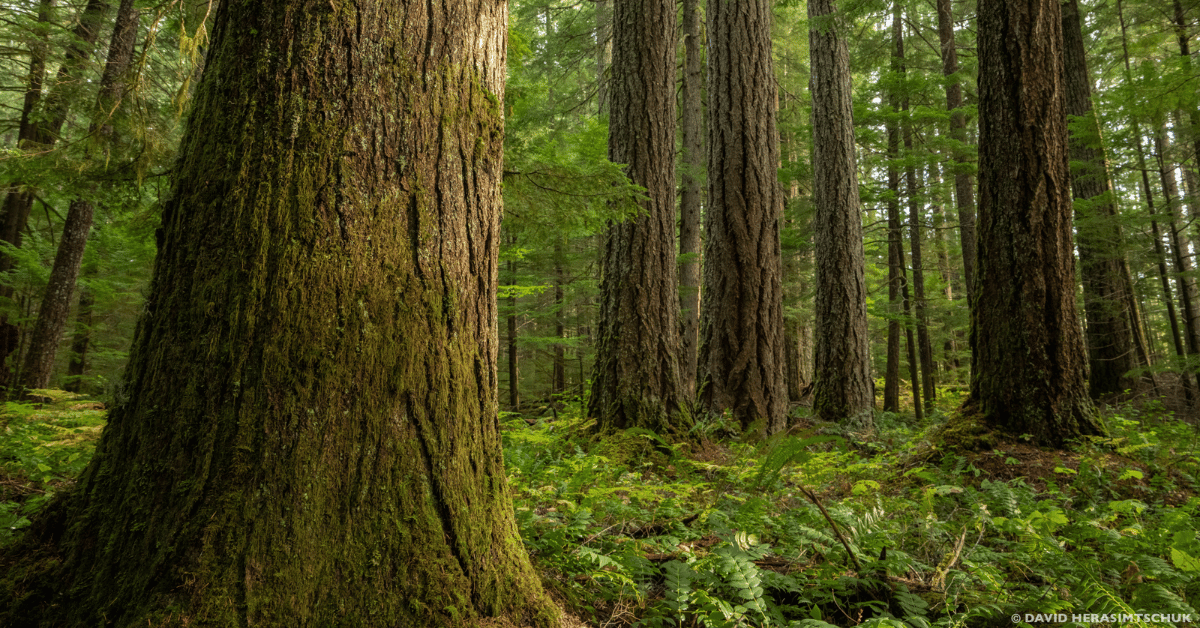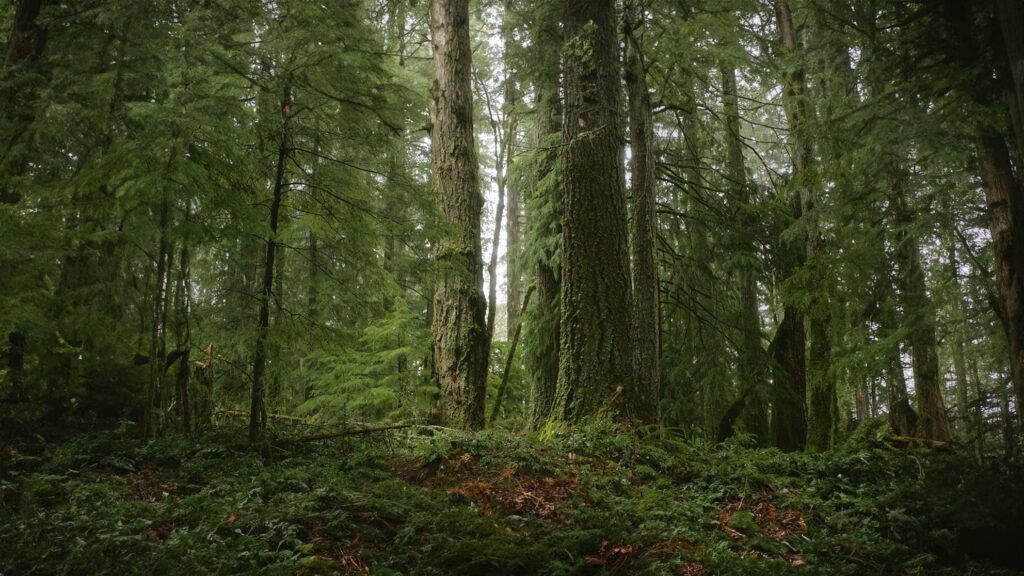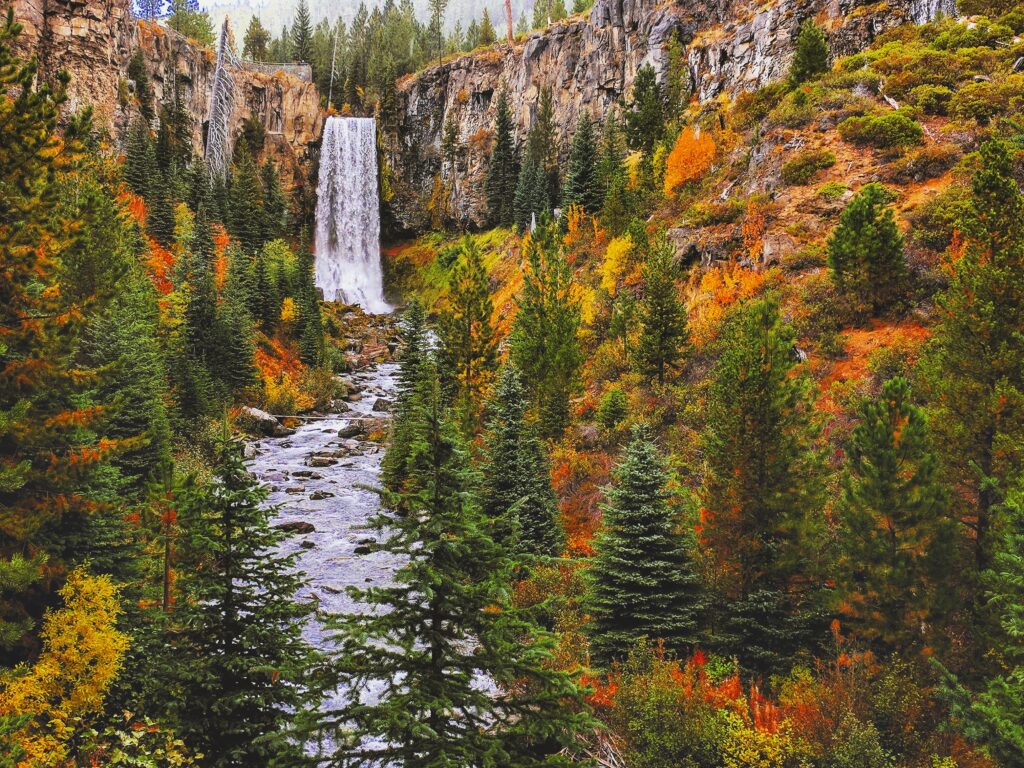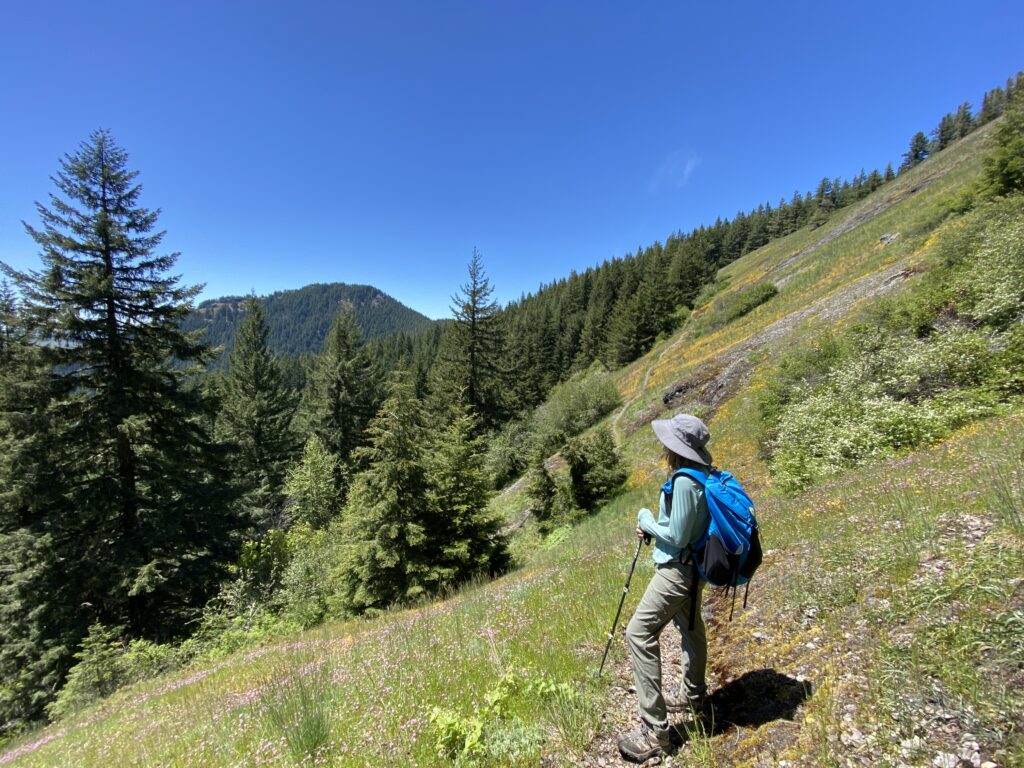For nearly 30 years, the Northwest Forest Plan (NWFP) has directed management in National Forests in western Washington, Oregon, and northern California. A compromise enacted in 1994, the NWFP aimed to protect and restore old-growth forests and healthy stream habitat for threatened species, while still facilitating logging on public lands. Since the Plan came online, it has led to great progress in restoring some of the damage done by decades of unsustainable logging – protecting drinking water, keeping other wildlife off the endangered species list, restoring salmon runs, stabilizing the climate, and improving quality of life which is the foundation of the growing regional economy.
While much has changed in the past few decades, the Plan left a million acres of mature and old-growth forest in areas open for logging, so there remains a compelling need for strong direction to protect forests for water, wildlife, carbon, wildfire resilience, and old forest protection and restoration.
What is the Northwest Forest Plan and why does it matter?
The Northwest Forest Plan came into being after decades of unsustainable clearcutting and road-building radically altered forest ecosystems and watersheds and led to the Endangered Species Act listing of old-growth forest-dependent species the northern spotted owl, marbled murrelet, and many stocks of salmon. Covering 24 million acres of federal forests in western Washington, western Oregon, and northwestern California, the NWFP attempted to strike a balance between logging and providing habitat for wildlife dependent on old-growth forests. The Plan defined areas for protecting and restoring old-growth habitat, set aside streamside areas to protect water quality and salmon habitat, and set strong standards for restoring forests and watersheds that were drastically damaged in previous decades.
Key components of the plan included designating large “reserves” for protection and recovery of old forest habitat conditions, generous stream buffers to protect water quality and habitat, a requirement to survey and protect rare species that may be in the path of old-growth logging (called Survey & Manage), and “matrix” areas between reserves where more logging is allowed.
The NWFP immediately slowed old-growth liquidation, brought improved management to federal forests within the range of the northern spotted owl, and in the 30 years that it has been in place there has been great progress in restoring some of the damage done by unsustainable logging of previous decades. Water quality and salmon habitat has improved, and the agencies are largely meeting their timber production targets by thinning in previously clearcut plantations rather than cutting mature and old-growth forests.
However, the plan is far from perfect. Some of the last remaining older forests remain unprotected. Logging of mature and old-growth forests is still allowed in “matrix” areas, and the Forest Service is exploiting loopholes to allow logging of old forests even within reserves. Logging and road building is allowed in many ecologically critical areas, including municipal watersheds, unroaded areas, and complex young forests recovering from fire. It also placed high expectations on timber production from these public lands.
Efforts to weaken the Northwest Forest Plan began as soon as it was finalized. When conservation groups used litigation to enforce the Survey & Manage Program, intended to protect rare species that live in old-growth, the Forest Service tried hard to weaken the rules. The Forest Service also sought to eliminate key aspects of the Aquatic Conservation Strategy under the plan, as well as efforts to weaken Endangered Species protections. The most consequential attack came from timber interests that opposed forest and habitat protections on Western Oregon BLM lands. They claimed logging should be the primary use of these public lands. A lawsuit settlement, initiated under the George W Bush administration, led to a revision of the BLM’s management plans in 2016. The revision essentially removed 2 million acres from the conservation framework of the NWFP, shrinking riparian reserves to just half their previous size and allowing more intense logging both inside and outside both riparian reserve and late successional reserves.
Despite its origins in addressing threatened species habitat, the NWFP has always been bigger than just the spotted owl. In defining areas for protection and setting strong standards for restoration, the NWFP has led to great progress in restoring some of the damage done by decades of unsustainable logging – protecting drinking water, keeping other wildlife off the endangered species list, restoring salmon runs, stabilizing the climate, and improving quality of life which is the foundation of the growing regional economy.
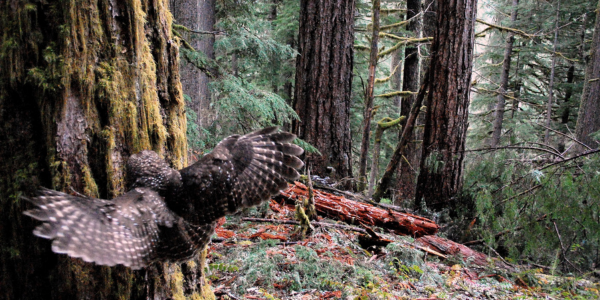
A northern spotted owl in flight by Kristian Skybak
Amending the Northwest Forest Plan
What’s changed?
Many things have changed since the Northwest Forest Plan was approved. To name a few:
- The global climate crisis is upon us. We know a lot more today about the role forests play in sequestering and storing carbon, and in providing vital climate refugia and connections for wildlife. In the decades preceding the Northwest Forest Plan, liquidation of the carbon-rich old-growth forests of the Pacific Northwest added significantly to the cumulative over-abundance of greenhouse gases in the atmosphere. The plan reduced logging to such an extent that northwest forests switched from being a source of carbon emissions to become a net sink of carbon. This highlights that forests can be part of the climate problem or part of the climate solution. In addition to the carbon benefits, mature and old-growth forests also offer stable climate refugia for wildlife that are trying to contend with extremes of climate change.
- There is no longer a social license to log mature & old-growth forests. This is reflected in the fact that on April 22, 2022 President Biden issued an executive order declaring a policy to conserve mature & old-growth forests on federal land and to manage forests to retain and enhance carbon storage. The agencies should immediately implement these policies.
- The barred owl, originally from eastern North America, has invaded the entire range of the northern spotted owl, and now competes with spotted owls for food and territory. Biologists tell us that we need to protect more old forest habitat to increase the chances that these two owl species can co-exist.
- The timber industry has shifted to rely mostly on small second-growth logs and the broader economy has changed and diversified. The regional economy added far more jobs than were lost due to federal logging restrictions. The future of the regional economy depends much more on maintaining our unique quality of life, not logging our last mature and old-growth forests.
- Climate-driven drought, weather extremes, and the impacts of decades of fire exclusion and suppression has led to more severe wildfires that threaten communities and the natural role of fire in forests.
- New science has confirmed the important role that mature and old-growth forests play in helping to stabilize water flows, which is critically important in an age of climate change. New science also shows that these forests are more resistant and resilient to wildfire compared to logged forests.
- Public lands legislation has protected some additional Wilderness areas, and policies like the Roadless Area Conservation Rule have protected intact forests in inventoried roadless areas, but many ecologically important smaller unroaded areas remain unprotected.
- The NWFP was based on both Forest Service and Bureau of Land Management Lands being managed under it, and BLM mature and old-growth forests being protected under its reserve system. Subsequent decisions removed the BLM plans, and today the Forest Service needs to expand and strengthen its own reserve system to compensate.
While updates to address these changes may indeed be warranted given changed circumstances, it is important that key pieces of the original plan are not weakened through an amendment or revision process.
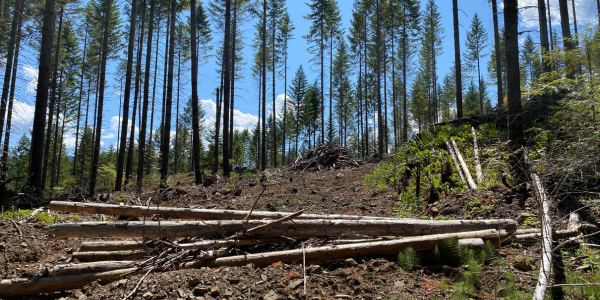
The Northwest Forest Plan attempted to balance conservation with logging
What’s going on?
In 2015, the Forest Service began considering if and how to revise management plans for national forests within the NWFP area. They held public listening sessions and completed an Assessment of the Management Situation and a Science Synthesis to inform the revision. The revision process was shelved during the Trump administration. In 2023, a federal advisory committee was convened to inform potential amendments to forest plans in Western Oregon, focusing on addressing wildfire risk, climate change, old-growth forests, tribal engagement, and rural communities and workforce.
The USFS has just released a notice with an amendment proposal. Under the National Environmental Policy Act (NEPA), the agency must provide the public an opportunity to comment on this proposal. Then, they must analyze the environmental impacts the amendments might have, as well as alternatives to their proposal. This analysis will then be available for further public review and comment. The USFS is aiming to complete the amendment by the end of 2024.
Last month, the agency released a proposal to amend the Forest Plans for the region and they are asking for public input during the scoping period.
While some of the proposal’s language could be interpreted as positive, much of it is dangerously vague and leaves a lot of room for Forest Service discretion that may actually weaken current protections. This is especially true in dryer forests, where we are concerned that the Forest Service is exploiting fear of fire as an excuse to log forests that evolved with fire, and that the plan amendment could lead to more logging of mature forest under the guise of fuel reduction. In addition, while the proposal acknowledges the need to address climate change and mentions President Biden’s Executive Order on this subject, the purposes section strangely doesn’t mention the urgent need for carbon storage or sequestration.
The Northwest Forest Plan continues to be instrumental in keeping Oregon a special place through the restoration of forests and watersheds damaged by past logging and road building, recovery of economically valuable salmon runs, protection of wildlife habitat and old-growth forests, and ensuring our National Forests are part of a natural climate solution.
Oregon Wild has concerns that the Forest Service is using a rushed and abbreviated planning process for this amendment. This plan is important, and in order to maintain and strengthen its ecosystem-based conservation goals, the agency should use a transparent, science-based approach that includes and reflects public values, Tribal concerns, and the needs of future generations.
In crafting an amendment to the plan, we hope the Forest Service will consider the following points:
- President Biden’s 2022 Executive Order on forests and the climate gave the Forest Service clear guidance that it should prioritize the protection and restoration of mature and old-growth forests (trees generally over 80 years old) across the nation as a natural carbon and climate solution. The Northwest Forest Plan governs the largest natural carbon reserves found anywhere in North America, and an amendment must recognize and safeguard the vast amount of carbon that can be sequestered and stored in these forests. The general direction to conserve trees over 80 years old in designated reserves has begun to reverse the loss of old-growth to logging, which in turn has turned PNW lands managed by the Forest Service from a carbon source to a carbon sink. However, not all of these older forests were protected under the plan, and every timber sale emits carbon to the atmosphere. The plan amendment should protect all mature and old-growth trees and forests.
- Preserving biodiversity and connected wildlife habitat across the region should be a core principle of any forest plan revision. This includes not only threatened species, but others that have been impacted by the loss and fragmentation of their habitat, and those pending for listing under the Endangered Species Act.
- Amendments should recognize the wide variety of social and economic benefits National Forests provide for local communities and the region as a whole, not just timber, but also clean water, climate stability, quality of life, and outdoor recreation.
- In light of the removal of BLM forests’ removal from the Forest Plan’s regional reserve system, new information about the importance of older forests for the climate, and the ongoing needs of wildlife for connected habitat, any amendment to the plan should enhance protected, connected, and redundant reserves by including all mature and old-growth forests and core wildlife areas without roads (1000 acres or larger). The reserve network, including riparian reserves, should have clear and enforceable limits on logging and road impacts.
- Fire resistance and resilience can be bolstered by preserving and restoring mature and old-growth forests. Fuels and fire management should focus on the home ignition zone and on non-commercial treatments and beneficial fire use, not commercial logging. Commercial logging for fuel reduction can negatively impact wildlife habitat, remove large fire-resistant trees, and create hazardous fire conditions. Standards must ensure that fuel reduction is both needed and effective before logging is allowed.
In short, we need a strong forest plan that addresses modern science and public values, tribal concerns, and the needs of future generations.



